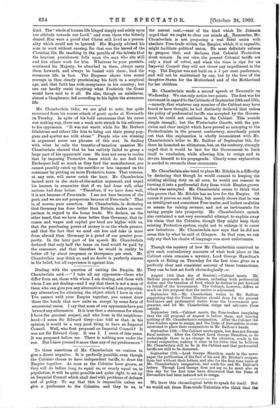Though the mystery of how Mr. Chamberlain contrived to give
such contradictory accounts of what took place at the Cabinet crisis remains a mystery, Lord George Hamilton's speech at Ealing on Thursday for the first time gives us a perfectly clear and consistent account of these transactions. They can be best set forth chronologically :— August 14th (last day of Session).—Cabinet meets. Mr. Balfour propounds a fiscal scheme, including both preferential duties and the taxation of food, which he desires to put forward on behalf of the Government. The Cabinet, however, differs so much on this proposal that the matter is adjourned.
September 9th.—Mr. Chamberlain writes to Mr. Balfour suggesting that the Prime Minister should drop for the present food-taxes and preferential duties from. the Government pro- gramme, and let Mr. Chamberlain resign and advocate them outside.
September 14th.—Cabinet meets, the Free-traders imagining that the old proposal of August is before them, and hearing nothing of Mr. Chamberlain's resignation. After the Cabinet thei Free-traders agree to resign, and the Duke of Devonshire is comL mis.sioned to place their. resignations in Mr. Balfour's hands.
September 15th.—The Cabinet meets again, but does not discuss fiscal matters. After the Cabinet Lord George Hamilton, as he understands there is no change in the situation, sends in his formal resignation, making it clear in his letter that he believes Mr. Chamberlain still to be in the Cabinet and that preferential tariffs are still to be discussed.
September 17th.—Lord George Hamilton reads in the news- paper the publication of the fact of his and Mr. Ritchie's resigna- tions but without their letters, and also for the first time hears of Mr. Chamberlain's resignation, and reads his and Mr. Balfour'S letters. Though Lord George does not say so, he must also on this day for the first time have discovered that the Duke of Devonshire had been induced not to resign.






















































 Previous page
Previous page